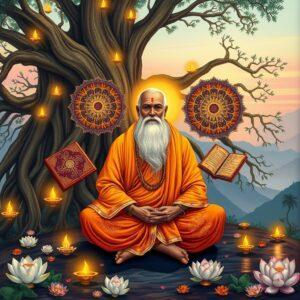
Sanskrit poetry, a treasured literary tradition of India, captivates with its intricate language, profound philosophical depth, and timeless beauty. This ancient language has profoundly shaped Indian culture, spirituality, and philosophical thought. Journey with us as we uncover the unique poetic devices and meanings that make Sanskrit poetry an enduring art form.
A Rich Tapestry of Poetic Expression
Dating back to the Vedic period, Sanskrit poetry boasts a rich history, with renowned poets like Kalidasa, Bhartrihari, and Bhasa contributing significantly to its evolution. From epic narratives to lyrical verses, Sanskrit poetry encompasses diverse forms:
- Epic (Mahakavya): These extensive poems narrate grand tales of gods, heroes, and mythical events, often exploring complex themes of dharma, karma, and human destiny. Examples include the Ramayana and Mahabharata.
- Lyric (Khandakavya): Shorter and more personal, lyric poetry expresses a range of emotions and reflections on life, love, and nature. Think of these as snapshots of intimate experiences and observations.
- Dramatic (Natya): Combining poetry, music, and dance, dramatic works bring stories to life on stage, exploring human emotions and conflicts with theatrical flair.
Religious and philosophical texts, such as the Bhagavad Gita and the Upanishads, seamlessly weave Sanskrit poetry into their narratives, enriching their spiritual and philosophical messages. The historical and cultural contexts of ancient India have profoundly influenced the development and themes explored in Sanskrit poetry.
Unveiling the Artistry: Poetic Devices
Sanskrit poets masterfully employ a range of poetic devices to enhance the beauty, depth, and impact of their verses. These tools create layers of meaning and evoke a spectrum of emotions in the reader:
- Alankaras (Figures of Speech): These literary ornaments add depth and complexity. Upama (simile), Rupaka (metaphor), and Anuprasa (alliteration) are just a few examples of how Sanskrit poets create vivid imagery and comparisons.
- Rasa (Emotional Flavor): Evoking specific emotions, rasa is the heart of Sanskrit poetics. From love (shringara) to heroism (vira), each rasa colors the poem with a distinct emotional tone.
- Chandas (Metrical Patterns): The rhythmic structure and musicality of Sanskrit poetry are governed by chandas. These metrical patterns create a pleasing flow and enhance the poem’s recitation.
- Dhvani (Suggestion) and Vakrokti (Indirect Expression): These techniques create layers of meaning beyond the literal words, inviting the reader to engage with the poem on a deeper, more interpretive level.
- Shlesha (Double Entendre): Adding wit and wordplay, shlesha uses words with multiple meanings to create clever puns and nuanced interpretations.
Delving into Masterpieces: Famous Sanskrit Poems
Sanskrit literature boasts a treasure trove of renowned works, each offering a unique glimpse into the poetic genius of ancient India:
- Kalidasa’s ‘Meghaduta’ (The Cloud Messenger): This lyrical masterpiece uses a cloud as a messenger to convey a yaksha’s longing for his beloved. The poem’s structure, themes, and vivid imagery have made it a classic.
- Bhartrihari’s ‘Vairagya Shataka’ (Hundred Verses on Renunciation): Exploring themes of detachment and spiritual liberation, this collection of verses offers profound philosophical insights into the nature of existence.
- Jayadeva’s ‘Gita Govinda’: This lyrical poem celebrates the divine love between Krishna and Radha, showcasing the beauty of devotion and spiritual longing.
- Panchatantra Fables: These animal fables, known for their moral and ethical lessons, have been translated into numerous languages and continue to entertain and educate readers of all ages.
- Rigveda Verses: The oldest of the Vedas, the Rigveda contains hymns and verses that offer metaphysical insights into the origins of the universe and the nature of reality.
Unlocking Wisdom: The Meaning Behind Sanskrit Shlokas
Shlokas, concise verses packed with meaning, are the building blocks of Sanskrit literature. These often-quoted verses encapsulate profound wisdom and spiritual teachings:
- Karmanye vadhikaraste ma phaleshu kadachana (from the Bhagavad Gita): This iconic shloka emphasizes the importance of performing one’s duty without attachment to the results, a core principle of Hindu philosophy.
- Asato ma sadgamaya (Lead me from the unreal to the real): This prayerful invocation seeks guidance on the path towards truth and enlightenment.
- Tat Tvam Asi (from the Upanishads, meaning “Thou art that”): This profound statement points to the ultimate unity of the individual self (Atman) with the universal consciousness (Brahman).
These shlokas are not merely ancient verses; they offer practical guidance for daily life, meditation, and spiritual growth. They remind us of essential values and principles that can enrich our lives.
Sanskrit Quotes: Timeless Wisdom for Modern Living
Sanskrit quotes, known as “subhashitas,” are gems of wisdom passed down through generations. These concise sayings offer profound insights into human nature, ethics, and the pursuit of a meaningful life. Here are some prominent examples:
- Aham Brahmasmi (I am Brahman): This powerful affirmation speaks to the realization of one’s true nature as part of the divine, interconnected with all of creation.
- Satyameva Jayate (Truth alone triumphs): India’s national motto, this quote underscores the ultimate power and enduring nature of truth.
These quotes reflect universal truths and ethical principles, offering guidance for navigating the complexities of both personal and professional life.
Ancient Wisdom for Contemporary Challenges
Sanskrit quotes offer valuable ethical guidance. For instance, Dharmo Rakshati Rakshitah (Dharma protects those who protect it) highlights the importance of upholding righteousness. This ancient wisdom provides a framework for navigating modern challenges with integrity and moral clarity.
Inspiration Across Time and Disciplines
Sanskrit quotes inspire creativity and reflection. Writers, artists, and thinkers draw inspiration from this rich tradition. Vasudhaiva Kutumbakam (The world is one family) promotes global unity and peace, a message of profound relevance in our interconnected world.
Preserving a Timeless Legacy
Efforts to preserve and promote Sanskrit are essential for safeguarding this rich cultural heritage. Institutions like Rashtriya Sanskrit Sansthan play a vital role in these endeavors. Digital platforms are instrumental in disseminating these teachings globally, making them accessible to a wider audience.
Poojn.in: Your Gateway to Sanskrit and Hindu Traditions
Poojn.in, India’s leading online store for cultural and religious products, offers a wide selection of resources to enhance your exploration of Sanskrit poetry and Hindu scriptures. Discover:
- Authentic Sanskrit texts and prayer books: Delve deeper into the verses and chants that form the heart of Sanskrit poetry. These resources provide valuable context and understanding.
- Traditional items for ceremonies and rituals: Enhance your spiritual practice with authentic items used in traditional Sanskrit poetry recitations and ceremonies.
- Statues and images of Devi Saraswati: Invite the blessings of the goddess of knowledge, music, and arts into your study space to inspire your exploration of Sanskrit poetry.
- Sacred items for creating a dedicated study space: Create a serene and inspiring environment for your study and contemplation of Sanskrit literature.
Visit poojn.in today to discover a curated collection of products that support your journey into the world of Sanskrit poetry and Hindu traditions.
Explore our range of:
- Prayer beads (mala) for meditation and recitation.
- Incense and other offerings to enhance your spiritual practice.


